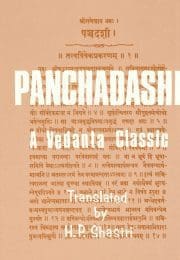Panchadashi
Panchadashi is a classic text on the non-dual philosophy by Swami Vidyaranya, that has been studied by serious students for centuries. It is one of the best sources from which to gain a thorough understanding of the non-dual view.
This philosophy is most helpful when studied alongside meditation and the other practices. Sometimes we find that our experiences challenge the conviction that all is ultimately one without a second, a supreme transcendental reality which is the Self in all. Sometimes the problems and complexities of the world provoke confusion and depression in our minds.
The real purpose of studying the non-dual philosophy is to provide a solution to these mental challenges when they occur, so that we can progress in the deepening vision of unity and ultimate Selfhood. All differences and difficulties arise in appearances, not reality.
Panchadashi is recognised as one of the best texts for helping us to do this.
The text deals in detail with how the apparent world that we experience through our senses can ‘arise’ from the non-dual reality. The aim here is not to give a definitive account of the nature of everything, which is not possible in words. The purpose is to provide us with ways of thinking and investigating that lead us to the discovery of the reality as our own being; and it is here, beyond words and thoughts, that the mystery is resolved.
To this end, the text discusses, in different ways, the various elements of our inner world, and the distinction between them all and the light of consciousness. One chapter considers carefully the four ‘great sentences’ by which the nature of the Self is indicated to those who have made themselves ready to understand.
Committed students of non-duality, particularly those in whom the intellect predominates, will find that Panchadashi is a valuable text for regular, dedicated study time.
From the Introduction by H P Shastri:
Whereas in the earlier Vedantic writers Maya and avidya are synonyms, Vidyaranya used these terms in a restricted and specialised sense. When the pure Sattva element of Prakriti is unsullied by Rajas and Tamas, he calls it Maya; and when Sattva is sullied by an admixture of Rajas and Tamas, he calls it Avidya. Brahman reflected in the medium of Maya is called Ishvara, and reflected in the medium of avidya is called Jiva [the conscious individual]. Swami Vidyaranya’s distinctive explanation of Jiva known as Abhasavada (reflection theory) has a classical basis in the Vedanta Sutras II.3.50 and no doubt owes something to the illustrations used by Shri Shankara of the reflection of the sun in a pot of water and the reflection of a face in a mirror. He defines Jiva as the ‘pure consciousness on which the subtle body is superimposed, together with the subtle body itself and the consciousness reflected in the subtle body.’
Selected verses:
Consciousness is distinct from the object but is not different from itself. There is a unity of consciousness in the dreaming and other states. It is therefore clear that one and the same consciousness abides in the three states. It is one and the same from day to day. [1:6]
This ever-abiding consciousness is the Self (Atman). It is the highest bliss since it is the object of the greatest love. For love of the Self is seen in the universal feeling “May I not cease to exist, may I continue to exist further”. [1:8]
Others are loved for the sake of the Self, but the Self is loved for its own sake and for none other. It is therefore clear that the Self, being an object of supreme love, is of the nature of highest bliss (Ananda). [1:9]
Reasoning and logic testify that the nature of the Self is existence, consciousness and bliss (sat-chit-ananda). The highest principle (Brahman) is declared by the Upanishads to be of the same nature. Thus Jiva (the individual consciousness) and Brahman are identical, and the Shruti affirms this identity. [1:10]
By applying the method of distinguishing between the variable and the invariable the Self can realise its disidentification from the five sheaths and its identity with the transcendent Brahman. [1:37]


